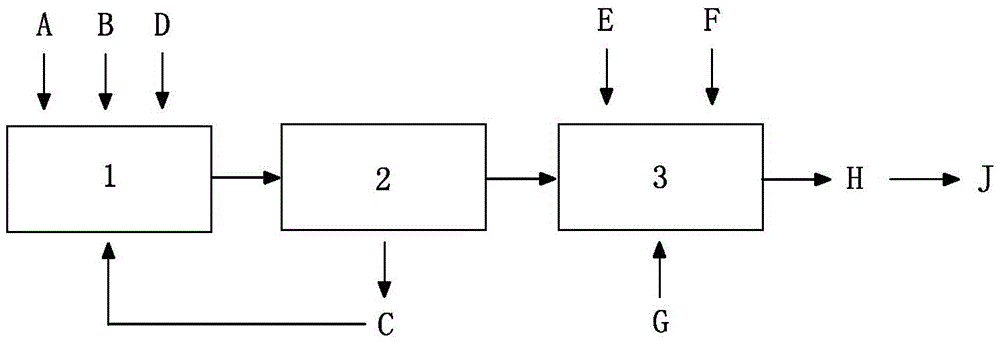A kind of polymerized bis-acid aluminum iron filter residue reuse process
A technology for polymerizing aluminum-iron bis-acid and filter residue, which is applied in the direction of iron compounds, inorganic chemistry, chemical instruments and methods, etc., can solve the problems of waste of resources, etc., achieve the effect of improving basicity, simple technical process, and ensuring human health
- Summary
- Abstract
- Description
- Claims
- Application Information
AI Technical Summary
Problems solved by technology
Method used
Image
Examples
Embodiment 1
[0027] 1) Add an appropriate amount of water G in the primary reaction kettle 1 (an enamel reaction kettle with a stirring device), start stirring, and add 120 parts of 31% hydrochloric acid and 6 parts of 98% sulfuric acid successively under normal pressure conditions; add 20 parts of filter residue C, Stir until the filter residue C is completely dissolved into a slurry; add 30 parts of iron-containing bauxite powder D, raise the temperature to 95-110°C, keep it under normal pressure for 3 hours, and take samples for detection; adjust the weight of hydrochloric acid, sulfuric acid and filter residue The number of parts is to control the basicity of the feed liquid in the primary reaction kettle at 19% ± 6% after the completion of the reaction;
[0028] 2) The feed liquid after the reaction is carried out liquid slag separation by liquid slag separation device 2, obtains mother liquor and filter residue C25 parts by pressure filtration of plate and frame filter press in the pr...
Embodiment 2
[0031] 1) Add an appropriate amount of water G in the primary reaction kettle 1 (an enamel reaction kettle with a stirring device), start stirring, and add 150 parts of 31% hydrochloric acid A and 5 parts of 98% sulfuric acid B successively under normal pressure conditions; add 30 parts of filter residue C, Stir until the filter residue C is completely dissolved into a slurry; add 40 parts of iron-containing bauxite powder D, raise the temperature to 95-110°C, keep it under normal pressure for 4 hours, and take samples for detection; adjust the weight of hydrochloric acid, sulfuric acid and filter residue The number of parts is to control the basicity of the feed liquid in the primary reaction kettle at 19% ± 6% after the completion of the reaction;
[0032] 2) Separating the reacted feed liquid through the plate and frame filter press 2 to obtain 25 parts of mother liquor and filter residue C; take the mother liquor and add it to the secondary reaction kettle 3 (an acid-resist...
Embodiment 3
[0035]1) Add an appropriate amount of water G in the primary reaction kettle 1 (an enamel reaction kettle with a stirring device), start stirring, and add 110 parts of 31% hydrochloric acid A and 12 parts of 98% sulfuric acid successively under normal pressure conditions; add 25 parts of filter residue C, Stir until the filter residue C is completely dissolved into a slurry; add 25 parts of iron-containing bauxite powder D, raise the temperature to 95-110°C, keep it under normal pressure for 3.5 hours, and take samples for testing; Parts by weight are at 19% ± 6% to control the basicity of the feed liquid in the primary reactor after the reaction is completed;
[0036] 2) Separating the reacted feed liquid through the plate and frame filter press 2 to obtain 25 parts of mother liquor and filter residue C; take the mother liquor and add it to the secondary reaction kettle 3 (an acid-resistant polymerization reaction vessel heated by steam), and start stirring , add an appropria...
PUM
| Property | Measurement | Unit |
|---|---|---|
| quality score | aaaaa | aaaaa |
Abstract
Description
Claims
Application Information
 Login to View More
Login to View More - R&D
- Intellectual Property
- Life Sciences
- Materials
- Tech Scout
- Unparalleled Data Quality
- Higher Quality Content
- 60% Fewer Hallucinations
Browse by: Latest US Patents, China's latest patents, Technical Efficacy Thesaurus, Application Domain, Technology Topic, Popular Technical Reports.
© 2025 PatSnap. All rights reserved.Legal|Privacy policy|Modern Slavery Act Transparency Statement|Sitemap|About US| Contact US: help@patsnap.com


